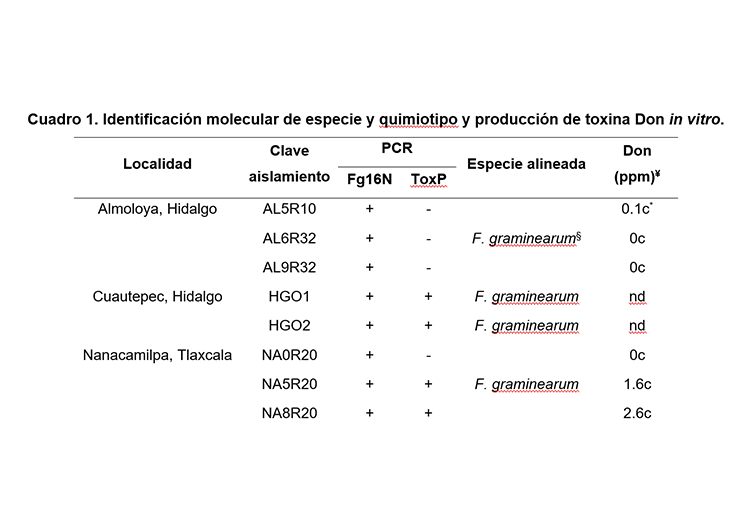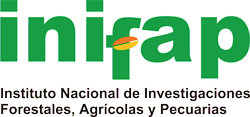Fusarium graminearum chemotype Don in malting barley grain grown in Mexico
DOI:
https://doi.org/10.29312/remexca.v16i2.3502Keywords:
Hordeum vulgare, deoxynivalenol, mycotoxinAbstract
Fusarium graminearum species cause Fusarium head blight, an important disease that affects grain yield and health quality in several barley-producing regions. Among the control measures is the use of resistant varieties, so this work aimed to isolate and morphologically and molecularly characterize isolates of F. graminearum from different malting barley-producing regions in Mexico and to identify those isolates with the greatest capacity to produce the Don toxin in vitro to recognize sources of genetic resistance. Thirty-nine isolates with morphological characteristics of F. graminearum were obtained, which were associated with malting barley grain from municipalities of High Valleys, El Bajío, and Tamaulipas. PCR reaction with species-specific primers Fg16N-F/Fg16N-R for F. graminearum confirmed the identity of 38 of the 39 isolates. The product sequences with Fg16N from 21 isolates annealed with the sequence of chromosome 1 of Fusarium graminearum, deposited in the GenBank-NCBI database. The PCR reaction with primers ToxP1/ToxP2 indicated that 17 of the 39 isolates correspond to the chemotype of F. graminearum that produces the Don toxin. Five of 33 isolates, analyzed by the Ridascreen® Fast Don test, registered the highest capacity to produce Don in vitro (3.4 and 17 ppm), so they can be considered to identify sources of resistance to Fusarium head blight in malting barley genetic improvement programs in the country.
Downloads
References
Bezerra, R. M. E.; Oliveira, F. F. Ch.; Feitosa, M. F. E.; Florindo, G. M. I. and Rondina D. 2014. Mycotoxins and their effects on human and animal health. Food Control. 36(1):159-165. https://doi.org/10.1016/j.foodcont.2013.08.021.
Bobadilla, M. M.; Hernández-Anguiano, A. M.; Zamora-Díaz, M. R. y Vargas-Hernández, M. 2019. Evaluación de líneas de cebada maltera a fusariosis de la espiga y acumulación de deoxinivalenol. Revista Mexicana de Ciencias Agrícolas. 10(3):485-498. https://doi.org/10.29312/remexca.v10i3.916.
Cerón-Bustamante, M.; Ward, T. J.; Kelly, A.; Vaughan, M. M.; McCormick, S. P.; Cowger, C.; Leyva-Mir, S. G.; Villaseñor-Mir, H. E.; Ayala-Escobar, V. and Nava-Díaz, C. 2018. Regional differences in the composition of fusarium head blight pathogens and mycotoxins associated with wheat in Mexico. International Journal of Food Microbiology. 273:11-19. https://doi.org/10.1016/j.ijfoodmicro.2018.03.003.
FDA. 2010. Food and Drug Administration. Guidance for industry and FDA: advisory levels for deoxynivalenol (DON) in finished wheat products for human consumption and grains and grain by-products used for animal feed. https://www.fda.gov/Food/GuidanceRegulation/ucm120184.htm.
Fong, Y. K.; Anuar, S.; Lim, H. P.; Tham, F. Y. and Sanderson, F. R. 2000. A modified filter paper technique for long-term preservation of some fungal cultures. Mycologist. 14(3):127-130. https://doi.org/10.1016/S0269-915X(00)80090-7.
Gilchrist-Saavedra, L. I. 2000. Problemas fitosanitarios de los cereales de grano pequeño en los Valles Altos de México. Serie de Conferencias Magistrales. In: XXVII Congreso Nacional de la Sociedad Mexicana de Fitopatología, AC. Revista Mexicana de Fitopatología. 18(2):132-137. https://www.redalyc.org/articulo.oa?id=61218211.
Joint Research Centre of the European Commission. 2007. Maize seeds sampling and DNA extraction. Report on the validation of a DNA extraction method from maize seeds and grains. 1-10 pp.
Leslie, J. F. and Summerell, B. A. 2006. The Fusarium laboratory manual. First edition. Ed. Blackwell Publishing. USA. 387 p.
Li, H. P.; Wu, A. B.; Zhao, Ch. S.; Scholten, O.; Löffler, H. and Liao, Y. C. 2005. Development of a generic PCR detection of deoxynivalenol- and nivalenol-chemotypes of Fusarium graminearum. FEMS Microbiology Letters. 243(2):505-511. https://doi.org/10.1016/j.femsle.2005.01.015.
Malihipour, A.; Gilbert, J.; Piercey-Normore, M. and Cloutier, S. 2012. Molecular phylogenetic analysis, trichothecene chemotype patterns, and variation in aggressiveness of Fusarium isolates causing head blight in wheat. Plant Disease. 96(7):1016-1025. https://doi.org/10.1094/PDIS-10-11-0866-RE.
Mert-Türk, F.; Gencer, R. and Kahriman, F. 2014. Chemotyping of the Fusarium graminearum isolates and variation in aggressiveness against wheat heads. The Journal of Animal & Plant Sciences. 24(6):1858-1862. http://www.thejaps.org.pk/docs/v-24-6/40.pdf. ISSN: 1018-7081.
Mesterházy, A. 2002. Role of deoxynivalenol in aggressiveness of Fusarium graminearum and F. culmorum and in resistance to Fusarium head blight. European Journal of Plant Pathology. 108(7):675-684. https://doi.org/10.1023/A:1020631114063.
McMullen, M.; Bergstrom, G.; De Wolf, E.; Dill-Macky, R.; Hershman, D.; Shaner, G. and Sanford, D. V. 2012. A unified effort to fight an enemy of wheat and barley: fusarium head blight. Plant Disease. 96(12):1712-1721. https://doi.org/10.1094/PDIS-03-12-0291-FE.
Mier, T.; Toriello, C. y Ulloa, M. 2002. Hongos microscópicos saprobios y parásitos: métodos de laboratorio. Universidad Autónoma Metropolitana Xochimilco (UAM)-X. México, DF. 54-57 pp. ISBN 970654609X.
Nicholson, P.; Simpson, D. R.; Weston, G.; Rezanoor, H. N.; Lees, A. K.; Parry, D. W. and Joyce, D. 1998. Detection and quantification of Fusarium culmorum and Fusarium graminearum in cereals using PCR assays. Physiological and Molecular Plant Pathology. 53(1):17-37. https://doi.org/10.1006/pmpp.1998.0170.
Warham, E. J.; Butler, L. D. y Sutton, R. C. 1997. Ensayos para la semilla de maíz y de trigo. Manual de laboratorio. Centro Internacional de Mejoramiento de Maíz y Trigo (CIMMYT). El Batán, Texcoco, Estado de México. ISBN: 968-6923-71-3. México. 84 p.
Walker, L. S.; Leath, S.; Hagler, Jr. W. M. and Murphy, J. P. 2001. Variation among isolates of Fusarium graminearum associated with Fusarium head blight in North Carolina. Plant Disease. 85(4):404-410. https://doi.org/10.1094/PDIS.2001.85.4.404.

Published
How to Cite
Issue
Section
License
Copyright (c) 2025 Revista Mexicana de Ciencias Agrícolas

This work is licensed under a Creative Commons Attribution-NonCommercial 4.0 International License.
The authors who publish in Revista Mexicana de Ciencias Agrícolas accept the following conditions:
In accordance with copyright laws, Revista Mexicana de Ciencias Agrícolas recognizes and respects the authors’ moral right and ownership of property rights which will be transferred to the journal for dissemination in open access. Invariably, all the authors have to sign a letter of transfer of property rights and of originality of the article to Instituto Nacional de Investigaciones Forestales, Agrícolas y Pecuarias (INIFAP) [National Institute of Forestry, Agricultural and Livestock Research]. The author(s) must pay a fee for the reception of articles before proceeding to editorial review.
All the texts published by Revista Mexicana de Ciencias Agrícolas —with no exception— are distributed under a Creative Commons License Attribution-NonCommercial 4.0 International (CC BY-NC 4.0), which allows third parties to use the publication as long as the work’s authorship and its first publication in this journal are mentioned.
The author(s) can enter into independent and additional contractual agreements for the nonexclusive distribution of the version of the article published in Revista Mexicana de Ciencias Agrícolas (for example include it into an institutional repository or publish it in a book) as long as it is clearly and explicitly indicated that the work was published for the first time in Revista Mexicana de Ciencias Agrícolas.
For all the above, the authors shall send the Letter-transfer of Property Rights for the first publication duly filled in and signed by the author(s). This form must be sent as a PDF file to: revista_atm@yahoo.com.mx; cienciasagricola@inifap.gob.mx; remexca2017@gmail.
This work is licensed under a Creative Commons Attribution-Noncommercial 4.0 International license.


